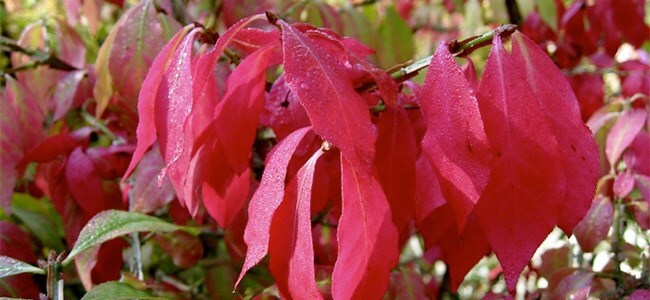|
Autumn is my favorite time of year. Yes the flowers may be fading away, eclipsed by shorter and cooler days, but there’s still plenty of foliage whether on the ground, or held aloft against a sinking sun. Touches of lipstick-red, sombre-burgundy, orange-peel and mustard-seed glow in autumn sunshine, before the leaves fall and scatter on the ground - almost too lovely to pick up. Tidy them from the lawn to protect the grass, but let them lay elsewhere if you can. The leafy layer will shelter small insects and hibernating amphibians, keeping them in your garden. This is a much greener, more-modern approach than the bare-earth policy of putting the garden to bed by cutting everything back. Instead, learn to enjoy the decadence and decay that autumn brings.
Lipstick reds
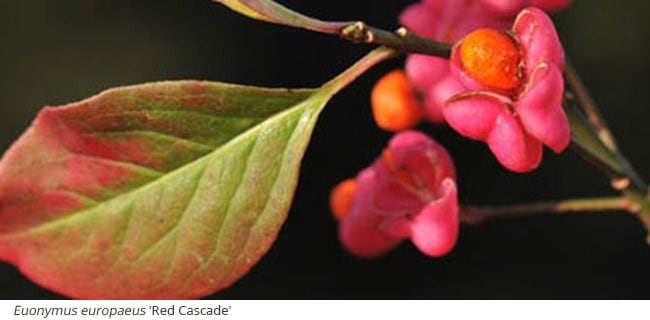
Bright red-pink is a touch-paper colour that glows in the autumn light, and there are certain shrubs and trees that display this sparkling shade. The earliest of all to colour up are the spindle trees, deciduous forms of euonymus that also bear spindle berries in day-glow orange and vivid pink. The fiery foliage always arrives by September and lingers for four weeks before the leaves drop. The strange winged fruits, suspended on straight stems, are loved by birds and often result in savage battles between rival robins desperate to keep them to themselves. Not surprisingly they disappear quickly. Good garden forms include ‘Red Cascade’, a small tree that’s easy, tolerant and smothered in spindles. The more shrub-like E. alatus bears lots of fruit and develops corky wings on the grey-brown bark, highly attractive in winter light.
More reds and pinks
If you like autumn foliage and red berries then you should love Cotoneaster ‘Hybridus Pendulus’. A small tree topped by lots of weeping branches studded with red berries and small leathery evergreen leaves that redden later in the year. Or you could add a sorbus such as ‘Eastern Promise’, a small tree with finely divided grey-green leaves, with pink berries and foliage that colours to orange in autumn. An AGM variety, ‘Eastern Promise’ is easier to grow than many and makes a perfect foil for pink hellebores because the berries persist over winter and into spring.
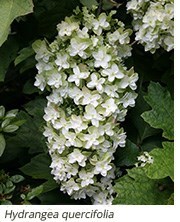 Small gardens can also get a blast of red using the oak-leaved hydrangea, H. quercifolia ‘Snow Queen’, in a container or tumbling over a low wall. The conical white flowers fade to pink against a chorus of red foliage, flecked in pink and coral, or you could use 'Snowflake' a later flowering form.This cultivar will still colour up beautifully in the autumn, but it has masses of long lasting pretty double florets making up the distinctive conical flowers. The compact Bergenia ‘Overture' is also perfect in a small space, with foot-high crimson leaves and lots of stems of bright-pink flower. Like all fleshy-stemmed bergenias it needs good drainage. Small gardens can also get a blast of red using the oak-leaved hydrangea, H. quercifolia ‘Snow Queen’, in a container or tumbling over a low wall. The conical white flowers fade to pink against a chorus of red foliage, flecked in pink and coral, or you could use 'Snowflake' a later flowering form.This cultivar will still colour up beautifully in the autumn, but it has masses of long lasting pretty double florets making up the distinctive conical flowers. The compact Bergenia ‘Overture' is also perfect in a small space, with foot-high crimson leaves and lots of stems of bright-pink flower. Like all fleshy-stemmed bergenias it needs good drainage.
Those same hints of pink develop on the burgundy leaves of Cotinus coggygria ‘Royal Purple’, although it’s larger and rangier. Cut back hard every year, only once established, it will develop larger lollipops at the expense of flower. If you want something smaller then choose Cotinus 'Ruby Glow', a newer variety which is much more compact, but no less dazzling with masses of fluffy pink flowers smothering the bush from midsummer, then spectacular autumn colour. Cotinus, commonly called smoke bushes due to their frothy flowers, come into leaf late and also lose their leaves late. This makes them useful additions to a prairie border - used with silver-awned 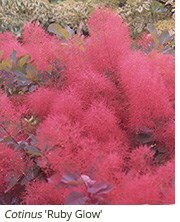 miscanthus. Or you could add warm-red glints with the evergreen shrub Photinia x fraseri ‘Red Robin’ or the newer form ‘Pink Marble’. Both have AGM awards and both produce red-tinted young growth that persists through winter. ‘Red Robin’ is a rich green and ‘Pink Marble’ a muted grey-green with cream. Both can be grown as specimens, or fused into a hedge. Cut both back in summer to promote young growth and underplant with spring-flowering blue muscari, to make the red tips seem even bolder. miscanthus. Or you could add warm-red glints with the evergreen shrub Photinia x fraseri ‘Red Robin’ or the newer form ‘Pink Marble’. Both have AGM awards and both produce red-tinted young growth that persists through winter. ‘Red Robin’ is a rich green and ‘Pink Marble’ a muted grey-green with cream. Both can be grown as specimens, or fused into a hedge. Cut both back in summer to promote young growth and underplant with spring-flowering blue muscari, to make the red tips seem even bolder.
Honey and mustard

The Katsura tree, Cercidiphyllum japonicum, forms a much larger tree so this isn’t for a small garden. The heart-shaped leaves of this Japanese tree, which emerge a rich-claret, are very prone to frost damage, so a sheltered position away from frost pockets is ideal. By the beginning of September the leaves of mature trees exude a burnt-toffee aroma, before the foliage turns to shades of honey and butterscotch.
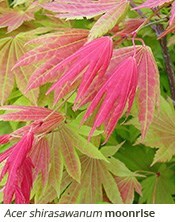 Japanese acers, named forms of Acer palmatum, also suffer from frost damage in spring, unless sited carefully. However they are slow-growing so make excellent container plants grown in rugged frost-proof pots. 'Sango-kaku' offers something for every season, with pink-red shoots and branches in winter, pink-green maple-like leaves in spring and mustard-yellow leaves in autumn.The delightfully named ‘Moonrise’ is a compact form for smaller gardens with emerging bright red foliage, maturing to an apple green, and then turning to a fiery red with orange hues in the autumn. Others are more finely divided such as 'Inaba-shidare' has finely-cut burgundy leaves in autumn. Acers are expensive due to their slow growth habit, but this is one tree that should be bought when it’s a few years old so that it’s developed form and shape. Although hardy, be prepared to fleece at the leafing-up stage. Japanese acers, named forms of Acer palmatum, also suffer from frost damage in spring, unless sited carefully. However they are slow-growing so make excellent container plants grown in rugged frost-proof pots. 'Sango-kaku' offers something for every season, with pink-red shoots and branches in winter, pink-green maple-like leaves in spring and mustard-yellow leaves in autumn.The delightfully named ‘Moonrise’ is a compact form for smaller gardens with emerging bright red foliage, maturing to an apple green, and then turning to a fiery red with orange hues in the autumn. Others are more finely divided such as 'Inaba-shidare' has finely-cut burgundy leaves in autumn. Acers are expensive due to their slow growth habit, but this is one tree that should be bought when it’s a few years old so that it’s developed form and shape. Although hardy, be prepared to fleece at the leafing-up stage.
Golden highlights
A glint of gold is always welcome, but when it comes to foliage most golds have retreated into green. A few grass-like plants hold the baton and they include Bowles’ golden grass - Milium effusum ‘Aureum’. The pale foliage keeps it colour in winter and in late spring finely beaded awns, also in pale-gold, follow. It is a self-seeder, but seedlings can be removed easily. It flowers in dank places too, and the pale-gold foliage looks sensational against bare soil late in the year.
Light and Shade

Variegated plants offer relief in shade, because they form patterns that look as though the sun is shining. Zebra grass, Miscanthus sinensis ‘Zebrinus’, was a Gertrude Jekyll favourite although she knew this green-blades grass with the golden horizontal bands as Eulalia japonica. The finer-tined ‘Morning Light’ is also Japanese in origin and they’ve appreciated its narrow grey-green leaves, vertically margined in white for centuries. It can look almost ghostly and it’s the perfect foil among vibrant flowers that might include purple asters. The same combination of white and sage-green, combining to give a steely gleam, occurs in some heucheras, including ‘Green Spice’. Or you could use our English holly, Ilex aquifolium 'Silver Queen' with its glossy deep green leaves, edged with a creamy white band and dark purple stems. Contrary to the name, it is actually a male holly so there are no berries, but it will provide lots of pollen to cross with other female hollies, so its presence in your garden will produce more berry.
Rich winter warmers in green
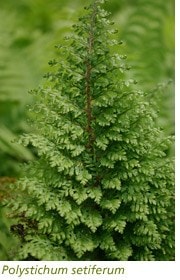 Green foliage begins to glow now, lifting the spirits on the first really cold mornings. The essential shrub, whether in a container or garden, is sarcococca because it will also provide winter fragrance. S. confusa is the most elegant with pendent clusters of ivory stamens supported by high-gloss green leaves. It avoids the metallic glints of other sarcococca foliage. Some hardy ferns also persist through winter and they include the orange-bristled forms of Polystichum setiferum, the soft-shield fern. ‘Herrenhausen’ has neatly arranged fronds that persist well in winter, with silk crocheted buds in April. The fussier, almost mossy Plumosomultilobum Group has 3D leaves, each one a miniature fir tree. Or, if you have somewhere dank and wet, opt for a ‘scolly’ or hart’s tongue fern - Asplenium scolopendrium. Green foliage begins to glow now, lifting the spirits on the first really cold mornings. The essential shrub, whether in a container or garden, is sarcococca because it will also provide winter fragrance. S. confusa is the most elegant with pendent clusters of ivory stamens supported by high-gloss green leaves. It avoids the metallic glints of other sarcococca foliage. Some hardy ferns also persist through winter and they include the orange-bristled forms of Polystichum setiferum, the soft-shield fern. ‘Herrenhausen’ has neatly arranged fronds that persist well in winter, with silk crocheted buds in April. The fussier, almost mossy Plumosomultilobum Group has 3D leaves, each one a miniature fir tree. Or, if you have somewhere dank and wet, opt for a ‘scolly’ or hart’s tongue fern - Asplenium scolopendrium.
Shiny periwinkles can also be used in wilder areas. The shorter Vinca minor comes in several forms, but the runners form a network of roots so this needs careful placing. V. minor f. alba 'Gertrude Jekyll’ is a pure-white single. ‘'Bowles's Variety'’ a lavender-blue and ‘Atropurpurea’ a dusky damson. The taller V. major also produces runners on long stems and is excellent against a wall, but the star is Vinca major 'Variegata', always popular with its creamy-white and green striking foliage, and large blue-violet, or dark violet flowers.
Rosettes

Rosettes shine against the bare soil, whether it’s verbascums, pulmonarias, or primroses. Give them a tidy in the autumn and they will help to make this time of year look fresher. Pulmonarias will have plenty of time to settle in if planted now, and ‘Opal’, an excellent low growing form, has long-lasting luminous blue flowers, emerging from pale pink buds from March to May which complement the narrow, well spotted semi-evergreen foliage. 'Silver Bouquet', a deciduous variety has very distinctive silver spotted foliage to help brighten up any autumn day. This will happily grow in a partially shaded spot under trees and shrubs, These rosettes shelter insects and the early flowers satisfy the bumblebee, for like all members of the borage family, the nectar is quickly replenished.
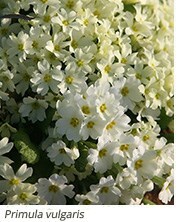 Primroses, lovers of cool shady places, also forms good rosettes and Primula vulgaris our native semi-evergreen primrose takes a lot to beat. Planted en masse in a woodland setting it lifts the heart in spring with an abundance of primrose yellow flowers. Combined with the gentian-blues of the deciduous Pulmonaria 'Blue Ensign’ it is stunning. But we are jumping ahead here, for now foliage is what matters - so learn to love it as much as your flowers. Primroses, lovers of cool shady places, also forms good rosettes and Primula vulgaris our native semi-evergreen primrose takes a lot to beat. Planted en masse in a woodland setting it lifts the heart in spring with an abundance of primrose yellow flowers. Combined with the gentian-blues of the deciduous Pulmonaria 'Blue Ensign’ it is stunning. But we are jumping ahead here, for now foliage is what matters - so learn to love it as much as your flowers.
|



